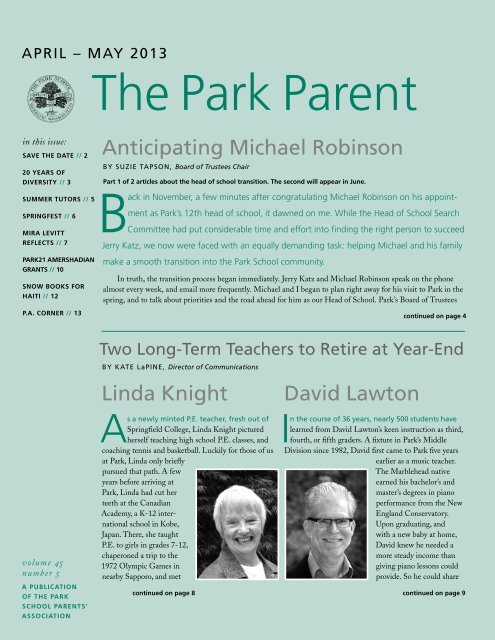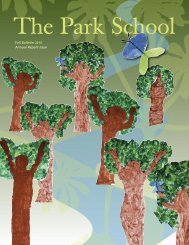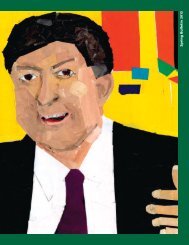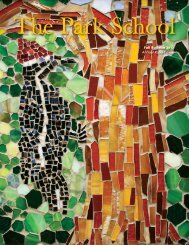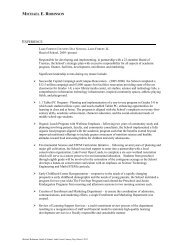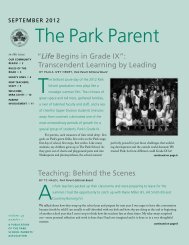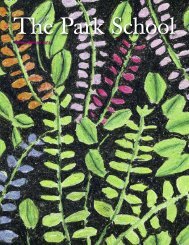The Park Parent April-May 2013 - The Park School
The Park Parent April-May 2013 - The Park School
The Park Parent April-May 2013 - The Park School
You also want an ePaper? Increase the reach of your titles
YUMPU automatically turns print PDFs into web optimized ePapers that Google loves.
APRIL – MAY <strong>2013</strong><strong>The</strong> <strong>Park</strong> <strong>Parent</strong>in this issue:SAVE THE DATE // 220 YEARS OFDIVERSITY // 3SUMMER TUTORS // 5SPRINGFEST // 6MIRA LEVITTREFLECTS // 7PARK21 AMERSHADIANGRANTS // 10SNOW BOOKS FORHAITI // 12P.A. CORNER // 13Anticipating Michael RobinsonBY SUZIE TAPSON, Board of Trustees ChairPart 1 of 2 articles about the head of school transition. <strong>The</strong> second will appear in June.Back in November, a few minutes after congratulating Michael Robinson on his appointmentas <strong>Park</strong>’s 12th head of school, it dawned on me. While the Head of <strong>School</strong> SearchCommittee had put considerable time and effort into finding the right person to succeedJerry Katz, we now were faced with an equally demanding task: helping Michael and his familymake a smooth transition into the <strong>Park</strong> <strong>School</strong> community.In truth, the transition process began immediately. Jerry Katz and Michael Robinson speak on the phonealmost every week, and email more frequently. Michael and I began to plan right away for his visit to <strong>Park</strong> in thespring, and to talk about priorities and the road ahead for him as our Head of <strong>School</strong>. <strong>Park</strong>’s Board of Trusteescontinued on page 4Two Long-Term Teachers to Retire at Year-EndBY KATE LaPINE, Director of Communicationsvolume 45number 5A PUBLICATIONOF THE PARKSCHOOL PARENTS’ASSOCIATIONLinda KnightAs a newly minted P.E. teacher, fresh out ofSpringfield College, Linda Knight picturedherself teaching high school P.E. classes, andcoaching tennis and basketball. Luckily for those of usat <strong>Park</strong>, Linda only brieflypursued that path. A fewyears before arriving at<strong>Park</strong>, Linda had cut herteeth at the CanadianAcademy, a K-12 internationalschool in Kobe,Japan. <strong>The</strong>re, she taughtP.E. to girls in grades 7-12,chaperoned a trip to the1972 Olympic Games innearby Sapporo, and metcontinued on page 8David LawtonIn the course of 36 years, nearly 500 students havelearned from David Lawton’s keen instruction as third,fourth, or fifth graders. A fixture in <strong>Park</strong>’s MiddleDivision since 1982, David first came to <strong>Park</strong> five yearsearlier as a music teacher.<strong>The</strong> Marblehead nativeearned his bachelor’s andmaster’s degrees in pianoperformance from the NewEngland Conservatory.Upon graduating, andwith a new baby at home,David knew he needed amore steady income thangiving piano lessons couldprovide. So he could sharecontinued on page 9
Save the dateSaturday evening • June 1, <strong>2013</strong>Cocktails, dinner & ProgramCelebrating twenty years of excellence in educationunder the leadership of Jerry Katz.We welcome current and former trustees, faculty, staff and parents,along with alumni through the class of 2012Formal invitation to followFor more information, please contact eliza Quincy ’98at 617.274.6022 or eliza_Quincy@parkschool.orgFeatured in the LibraryPlease visit the library to enjoy these featured books andexplore the new horizons they present.<strong>The</strong> book for <strong>April</strong> is: Brothers at Bat: <strong>The</strong> True Story ofan Amazing All-Brother Baseball Team by Audrey Vernick,illustrated by Steven Salerno. <strong>The</strong>mes include sports, history,families, biography, facts, and statistics.<strong>May</strong>’s book is: A Leaf Can Be ... by Laura Purdie Salas,illustrated by Violeta Dabija. <strong>The</strong>mes include nature,imagination, discovery, colors, and poetry.<strong>The</strong> <strong>Park</strong> <strong>Parent</strong> // PAGE 2
Diversity at <strong>Park</strong>: A 20-Year PerspectiveBY JERROLD I. KATZ, Head of <strong>School</strong>HEAD’S LINESBack in January 2012, when I announced my plans to leave<strong>Park</strong> <strong>School</strong> at the conclusion of the 2012-13 academic year,I wrote that it was “not the time to review the record of myyears at <strong>Park</strong>.”Now, fifteen months later, as increasing attention is beingpaid to leadership transition planning, I am beginning to join othersin looking back at <strong>Park</strong>’s evolution over the past twenty years.I am particularly proud of the fact that <strong>Park</strong>’s development as adiverse, just, and inclusive community will be part of my legacy.It’s interesting to look back at my very first <strong>Park</strong> <strong>Parent</strong> article,published in September 1993, to capture both changes over timeand the unchanging nature of diversity work as a critical aspectof implementing <strong>Park</strong>’s mission. Here is an excerpt from twentyyears ago:Since my first visit as a candidate last fall and throughout thepast six months of my transition, it has been apparent to me thatattempting to clarify where the <strong>School</strong> is and where it might beheaded in regard to diversity would require my immediate attentionas Head of <strong>School</strong>. Embracing diversity is a central componentof <strong>Park</strong>’s mission as conveyed to me and to all of us by the Board ofTrustees. Yet, it has become a topic for many members of the <strong>Park</strong>community that appears to be associated with varying degrees ofconfusion and concern. Perhaps this should not surprise any of us,because similar struggles for identity currently characterize theexperience of many independent schools and indeed our nation.Our ability as adults to embrace and to talk to each other aboutdiversity is critical, however, to our ability to prepare our studentsfor leadership roles in the society they will inherit. This would beimportant, no matter who our students were at <strong>Park</strong>, although ourconversation is greatly enriched and deepened by the diversity thatis currently found here.In 1993, the diversity conversation at <strong>Park</strong> was largely centeredon race. Why was it important for the <strong>School</strong> to attract andretain families and faculty of color, and how could these goals beaccomplished? Was “multicultural education,” with its commitmentto exposing students to different voices in English and todifferent perspectives in history, compatible with a commitmentto academic rigor in the curriculum? I soon discovered a less openconversation about religion. Could Yule Festival be “comfortable”for Jewish and other minority members of the community,while still “working” as a meaningful celebration for the Christianmajority at <strong>Park</strong>? In 1993, it was not yet clear that it was “safe” toeven talk about differences in family configuration, sexual orientation,and/or socioeconomic class within our community.In <strong>2013</strong>, we are not only a much more diverse school, we arealso much more united in our diversity beliefs and aspirations.Students of color, less than 10 percent of our population in 1993,now make-up over 35 percent of our student body across GradesPre-K-IX. Financial aid, limited to a small number of UpperDivision students in 1993, is now extended to over 23 percent ofall students across every grade. LGBT parents, faculty, and studentsare now openly welcomed and supported as valued membersof our community. We recognize differences in learning styles,and we work hard to differentiate instruction to provide challengeand to facilitate success for a range of learners in our classrooms.<strong>Park</strong> has become a school of choice for many different kindsof families, and it has become a place where many different traditionsand expressions of identity can be comfortably shared. Ofequal importance, all students at <strong>Park</strong> today are growing up in acommunity where they are learning to appreciate interdependenceand to make connections with a broad range of others.Many determined, and often courageous, people have led<strong>Park</strong> forward on its journey to being a more inclusive communityover the past twenty years. Trustees, administrators, faculty, staff,students, and parents have all been leaders in this effort. Whatever“credit” is attributed to me over the months ahead must beshared with many others who advocated for themselves, for theirchildren, and for the improvement of the experience of all membersof our community.I closed my September 1993 <strong>Park</strong> <strong>Parent</strong> article with wordsthat still resonate today:I believe that it would be fair to say that in its commitment torespecting diversity, <strong>Park</strong> <strong>School</strong> has at times stumbled in the past;no doubt, there will continue to be some missteps in the future. Forsome, there will be impatience with the rate of change; for others,the pace of <strong>Park</strong>’s adjustment to a changing world may alreadyseem alarming.<strong>The</strong>re are many other areas to work on during the comingmonths. Certainly, new initiatives in the teaching of math, science,and technology have surfaced as high priorities. However,thoughtful reflection about diversity will always need to remainon <strong>Park</strong>’s agenda, if this important aspect of the <strong>School</strong>’s missionis to be realized.When it comes to being a diverse, just, and inclusive schoolcommunity, building upon the legacy of the past twenty yearssoon falls not just on Michael Robinson. It remains the responsibilityof every adult within this community.APRIL-MAY <strong>2013</strong> // PAGE 3
Anticipating Michael Robinson, continued from page 1formed a Transition Committee to address a wide array of concerns– from helping Michael and his family relocate to Boston,to identifying key dates for his calendar, to keeping <strong>Park</strong>’s dailyroutine as regular as ever.Jerry has been instrumental in helping us identify prioritiesfor Michael. “When I first started at <strong>Park</strong> 20 years ago,” Jerryrecalls, “it was important for me to know the <strong>School</strong> through theeyes of the faculty and staff.” Getting to understand and appreciatethe individuals in our community enabled him to buildpartnerships. Thanks to Jerry’s suggestion, Michael is lookingforward to one-on-one meetings with each of <strong>Park</strong>’s 160 employees.He will begin the meetings when he arrives in July and hopesto wrap up in the early fall. Once school opens in September, hewill then begin acquainting himself with our 560 students andmore than 700 parents!Jerry also recommended that we try to make Michael’s personaltransition to <strong>Park</strong> as seamless as possible. “A key ingredientof Michael’s professional transition is ensuring a smooth personaltransition too,” he advised. When Jerry began his headship, hewas quite familiar with Brookline and its surrounding communitieshaving been a Newton public school principal for many years.Jerry recalls, “I had a simpler transition personally but a biggertransition professionally.”BecauseTransition TeamMichael has ledVinny Chiang, Co-Chairthree independentLanny Thorndike ’81, Co-Chairschools before comingto <strong>Park</strong>, he isCynthia HarmonHeidi Johnsonfamiliar with theirPatti Kraftunique managementAmy Lloyd McCarthy ’86challenges: workingwith a Board ofKatie McWeenyPete RiehlTrustees, fundraising,and managingSarah RoseBea Sandersan operating budgetSuzie Tapson, ex officioto name a few.However, Michaelwill need all of us to help him get to know the <strong>Park</strong> community,Brookline, and the surrounding towns.With that in mind, we are pleased to announce that theRobinson family will be living at 133 Goddard Avenue, theformer home of Nancy and Kim Faulkner ’45. In December, the<strong>School</strong> bought the Faulkner property – 8.3 acres adjacent to the<strong>Park</strong> campus. <strong>The</strong> purchase was funded primarily through dona-A <strong>Parent</strong>’s Perspective on the TransitionBY PADMAJA RAMAN, <strong>Park</strong> <strong>Parent</strong> Editorial BoardIt is a rare and exciting opportunitythat we <strong>Park</strong> <strong>School</strong> parents get towelcome a new leader into our community.As Jerry prepares to bid us adieu and headto the Big Apple, we are poised to welcomeMichael Robinson as our 12th head ofschool on July 1st.Jerry is leaving us with a strong,successful school with an establishedfaculty and staff that has become part ofmy daily routine. As a new parent in thefall of 2004, I recall Mrs. Ball greetingme with her warm, reassuring smile andMr. Segar’s cheerful greeting at drop off.Fast forward nine years and those <strong>Park</strong><strong>School</strong> institutions remain constant andheartwarming. In the midst of all that isfamiliar and constant, we are sure to missJerry’s ubiquitous presence next fall.My friend and fellow <strong>Park</strong> parent,Elizabeth B. Lamont, remarked aboutthe change in leadership: “Jerry is anoutstanding academic leader who willmost certainly provide all the elementsneeded for a smooth transition for MichaelRobinson. <strong>The</strong> most important thing wecan do,” she continued, “is to welcomeMichael Robinson to the <strong>Park</strong> communitywith open arms. We can show support,respect, and patience as he begins tolearn about this wonderful place that wealready know so well. We should standready to help him in anyway that we can,and as part of that, be able to talk openlyabout areas that are working well as wellas areas that might benefit from change.Kindness and candor cannot be oversold attimes of transition.”Heads of schools take on an enormoustask of leading a team who are responsiblefor educating the next generation. Havingobserved Jerry over the years, his passionand commitment to improving thequality of education has always beenstrong. Based on Michael’s presentationto our community last fall and havingread about his professional experiences,I believe that he will bring a similarpassion into his new role at <strong>Park</strong>. <strong>The</strong>task of leading a school requires dedication,as it is a continuous journey involvingopportunities, changes and challenges overtime. This type of dedication is what wesee in both Michael and Jerry, who willbe leaving familiar grounds and movingto new schools to continue their sharedmission of bringing excellence to education.Michael, we look forward towelcoming you and your family, andworking with you as part of the <strong>Park</strong>community. Jerry, good luck and bestwishes to you! Your toughest challenge isnot to succumb and switch your allegiancefrom our beloved Red Sox to that teamcalled the Yankees!<strong>The</strong> <strong>Park</strong> <strong>Parent</strong> // PAGE 4
tions raised as part of our <strong>Park</strong>21 initiatives, though thefundraising is ongoing. <strong>The</strong> main goal in purchasingthe Faulkner property was to give <strong>Park</strong> the flexibility tobuild more on the existing campus when future needsarise, something we could not do without purchasingadditional property. Another benefit of the landpurchase is that <strong>Park</strong> now has a home for our Head of<strong>School</strong>. This lovely, contemporary house will provideMichael and Frances Robinson with a home base rightnext door to the <strong>School</strong>.Although Michael is still actively leading the LakeForest Country Day <strong>School</strong> outside of Chicago, he willbe in Boston for a two-day visit in <strong>May</strong>. <strong>The</strong> TransitionTeam has planned a jam-packed 48-hours for him –including meetings with Jerry, the Administrative team,and the Board of Trustees. Our hope is that this quickforay into the <strong>Park</strong> <strong>School</strong> world will help Michael hitthe ground running on July 1st.133 Goddard Avenue, the home of Nancy & Kim Faulkner ’45 for 40 years, willbecome the residence for Michael Robinson and his family.PARK FACULTY AVAILABLE FOR TUTORING SUMMER <strong>2013</strong>NAME SUBJECTS GRADES AVAILABLE E-MAIL PHONELiga Aldins French and Spanish K – 12 August, early September AldinsL@<strong>Park</strong>school.org 781-326-7823Lila Austin reading, writing, K-7 June, July AustinL@parkschool.org 617-477-4220spelling, handwritingSarah Bourque reading, writing, math K–2 June, July, August BourqueS@parkschool.org 617-549-9467Peter Bown math, reading, writing 1 – 5 June, July, August BownP@parkschool.org 617-230-3071Kung-Yi Chang math through calculus AB-BC; 4 – 12 June, July, August ChangK@parkschool.org 508-314-3075SSAT, PSAT, ACT, ISEE, and SAT prepMulian Chen Mandarin K-12 July, August mulian20@hotmail.com 617-818-0399Danny Chin French, English, 5–12 June, July, August d.j.chin12@gmail.com 617-875-0792science, mathAshley Chow English 6 – 9 June, August aechow@gmail.com 603-930-6633Kathy Coen English, writing 6 – 9 June, July, August CoenK@parkschool.org 617-223-1964group or individual tutoringBeth Donnell-Kilmer reading, writing, language arts 1 – 7 June, July, August KilmerB@parkschool.org 617-327-7760Greg Grote Latin, including AP 6-12 June, July, August GroteG@parkschool.org 617-477-9119introductory GreekKristin Hoins language arts, math, science 3-7 June, July, August khoins@gmail.com 970-708-0032integrated/multidisciplinary project-based learningTaylor Horan math 5 – 8 June, July, August HoranT@parkschool.org 508-254-7980Emily Medford math, reading, writing 1 – 5 June, August emilymedford15@gmail.com 870-589-1288Katrina Mills math K-5 July, August MillsK@parkschool.org 617-543-0595Paul Newmark French K-12 July, August NewmarkP@parkschool.org 617-455-9386Steve Savage strength and conditioning age 10 – adult June, July, August SavageS@parkschool.org 781-258-1326Alli Smith math, reading, spelling, writing K-5 June, July, August SmithA@parkschool.org 617-274-6069Laurie Turner math, ISEE, SSAT prep 2–9 June, July, August TurnerL@parkschool.org 617-923-7644APRIL-MAY <strong>2013</strong> // PAGE 5
COME!Ticketsgo on saleSUNDAY, MAY 19th, <strong>2013</strong>HELP!We need you on<strong>May</strong> 19th!Don’t forget tosign up tovolunteer!DONATE!Please solicit yourfavorite businessor donate an itemdirectly to thesilent auctionSilentauctionunderthe tent!Free prizes,face-painting,yummy foodand more!Lots ofrides andgames!Amazing<strong>The</strong> <strong>Park</strong> <strong>Parent</strong> // PAGE 6www.parkschool.org/springfestSpringfest Co-Chairs: Suzanne Samuels, Sara Strand, Nancy PincheraAuction Co-Chairs: Keisha Burgess, Rebecca ScottRaffle Co-Chairs: Dana Lewis & Betsey Gifford
<strong>Park</strong> ReflectionsBY MIRA LEVITT, Acting Psychologist and Former <strong>Parent</strong>s' Association PresidentWhen you live in a place with someone day in and dayout, it can sometimes be hard to recognize the changesthat take place. It is not until you take out the photoalbum (does anyone have these anymore?) or look at the heightmarks on the wall that the transformations which have gone undetectedor unappreciated become obvious and undeniable. Returningto <strong>Park</strong> after seven years to fill in as psychologist for OliviaMoorehead-Slaughter while she was on sabbatical, I was struck byboth similarities and differences in the school since my departure,and gained some new perspectives as a member of the faculty.<strong>The</strong> most obvious change is the physical expansion, a hugeundertaking that was merely an idea when I left the school. <strong>The</strong>efficient and effective execution of this plan resulted in the NorthWing, so seamlessly integrated with the rest of the building, andenlargement of existing classrooms. <strong>The</strong> second notable change isthe extent to which <strong>Park</strong>’s longstanding commitment to diversityhas been further reified throughout the faculty and student body.<strong>The</strong> changes in the population have not been undertaken simplysymbolically, but with meaningful integration of and appreciationfor the value of different life perspectives. Finally, I was struckby the degree to which technology is now utilized by faculty andstudents alike. It has been implemented not as superficial windowdressing, but to keep instruction at the cutting edge, and withsensitivity to the associated dangers and pitfalls.Notwithstanding these (and many other) changes, I wasdelighted to see that the basic fundamentals of <strong>Park</strong> have notchanged, including the sense of excitement and potential for theday ahead that pervades the arrival of students in the morning.Similarly, there is no change to <strong>Park</strong>’s unwavering dedication, evenin the midst of an impending transfer of leadership, to pursuingnew educational strategies, new knowledge about how childrenlearn, and new partnerships, as opposed to being satisfied withpast achievements. In other words, <strong>Park</strong>’s insistence on change forthe better has itself not changed.Having been a parent at <strong>Park</strong> and President of the <strong>Parent</strong>s’Association, I had many opportunities to interface with <strong>Park</strong>faculty and staff, and my new vantage point only augmentedthe admiration I always had for these professionals. I now knowfirst-hand of the respect and support (emotional, technological,etc.) that is given to faculty in order to facilitate their ability to dotheir jobs. I observed the care and thought that is put proactivelyinto supporting children, parents, and faculty in times of crisis,such as the Sandy Hook tragedy. I was made constantly aware ofthe preparation time, sensitivity, and genuine care that goes intoensuring that every child’s experience at <strong>Park</strong> is maximized, andinto the quality of communicationwith parents aspartners in this process. Inthis regard, I was also in aposition to appreciate thestruggles and sincere effortsof parents who want somuch for their children tobe happy and to succeed. Inaddition, as one who wasnow on the receiving-end, Imore fully understand thevalue of the efforts that the<strong>Parent</strong>s’ Association makeson behalf of our faculty andstaff. For example, thoughit may not sound as critical as faculty grants or committees such asCommunity Service, having an attractive room in which to takea break and to partake of edible goodies (all courtesy of the P.A.)offers a much needed boost of energy that can make all the differencein the frame of mind with which one returns to work.Finally, I had a new window into the nature of the studentsat <strong>Park</strong> whom I had previously known only as the peers of my ownchildren. With Olivia’s help, I was able to continue her traditionof handing out mints to Upper Division students on their break(She left me well stocked). <strong>The</strong>se poised young people came intomy office with bright, shining faces, brimming with appreciativepleases, thank yous and engaging conversation. Yes, there wasthe occasional “negotiator” (you know who you are) who triedto wheedle out extras, but it was done in good humor and (whoknows?) may even prove to be a useful skill someday. Whether itwas upper division students typing away on laptops as they sat onthe floor of the hallways, Middle Division students coloring collaborativelyin the hallway to create a wall map, or Lower Divisionstudents creating a veterinary clinic (including a sign-in registrationdesk—so cute!), the level of engagement that students bringto their work is striking and poignant.I have probably not told you anything you did not alreadyknow, but I hope that as a returning member of the community,I have given you a booster shot of appreciation for how wonderfulit is to be at <strong>Park</strong> <strong>School</strong>, and how lucky your children are tobe growing up in this environment. My time at <strong>Park</strong> flew by, andI confess that it was very difficult for me to leave, yet again, inMarch. Thanks to you all, as well, for having welcomed me sograciously.APRIL-MAY <strong>2013</strong> // PAGE 7
Linda Knight, continued from page 1her life partner, Betsey Greenman.Upon returning to the United States, she accepted a jobteaching P.E. at <strong>The</strong> <strong>Park</strong> <strong>School</strong>. Over the course of her 40years on Goddard Ave., Linda has taught literally thousands ofstudents – from four-year-olds on balance beams to Grade VIjuggling classes. Linda is always measured and kind, and expectsevery student to make his or her best effort. On Linda’s very firstday in September 1973, she insisted that all the girls wear socks toP.E. “I remember that the girls complained vehemently about meand this requirement to Margo Smith, who was Assistant Head atthe time.” But Linda would not yield, and at the year-end athleticsaward ceremony, she received a bottle of champagne as a thankyou from the Grade IX girls, who had come to love and acceptMs. Knight.Socks were not the only change Linda brought to the P.E.curriculum. First, she and the department determined that theboys and girls would have co-ed classes – after all, it was 1973,the era of equal rights for women! In the spirit of equality, sheadded a Morris stick dance to <strong>May</strong> Day so boys could participate,too. By her second year, Linda had become the head of theP. E. Department. She took a fresh look at the pedagogy and skilldevelopment that students would encounter during their years at<strong>Park</strong>. Linda’s philosophy was to separate the essence of physicaleducation and athletics. “<strong>The</strong>y really have two separate goals,”she explains. “P.E. is all about introducing kids to a wide arrayof activities and skills and encouraging them to participate. Wewant students to enjoy being active for life!” After-school sportsat the middle school level provide children a competitive experience,specialization, and choice, but they’re not for everyone.Linda notes that the athletic landscape has changed dramaticallyin 40 years. “<strong>The</strong> <strong>School</strong> only had 350 students when I arrived,”she says, “and there really weren’t any town sports to speak of, soeveryone supported the <strong>Park</strong> teams with gusto. Gymnastics werehuge in the 70s and 80s, and more than 100 kids participated in aSaturday gymnastics program that we ran.”Over time, Linda gravitated away from coaching and devotedmore of her time to teaching. “While I spent many years coachinggirls’ basketball, lacrosse, and field hockey, and co-ed gymnastics,I always had a passion for getting kids active and helping thosewith lesser skills succeed.”Since 1990, Linda Knight has also been synonymous with<strong>Park</strong>’s Internship in Teaching Program. Former Headmaster BobHurlbut started the program over 40 years ago with the intentionof letting well-educated young people try out teaching in anelementary school. “Most established internship programs werein high schools, and most had a required grad school component,”Linda explains. “Bob’s hope was to let recent college graduatesdiscover how much fun and rewarding teaching <strong>Park</strong>-agedstudents could be.” Under her leadership, Linda has endeavoredto maintain the original spirit of the Intern Program. “Bringingseven or eight bright, well-educated individuals to experienceteaching at <strong>Park</strong> every year is exhilarating,” she says. “And it’sincredibly rewarding to see so many former interns thrive as membersof the faculty,” recalling Melody Bartlett, Dorothea Black,Peter Bown, LaToya Downing-Peltier, Tracy Duliban, DanEberle, Kyra Fries, Liesl Gilman, Meg Lloyd, Paul Newmark,Jessica Niebuhr, Christian Porter, Jen Riley, Sarah Rose, RituSingh, Paul Toussaint, and Leah Walters among her protégés.Other former interns are making their mark on education acrossthe country – from Brendan Largay, head of Meadowbrook’smiddle school, to Ronnie Codrington, who assumed the helm ofthe Evergreen <strong>School</strong> in Seattle this year.“I’ve had the opportunity to wear many hats at <strong>Park</strong>,” Lindareflects, “which has allowed me to develop talents I didn’t evenknow I had. At <strong>Park</strong>, you don’t get pigeon-holed into your subjectarea.” Linda served on the first Faculty Compensation Committee,and in 1995, Linda coordinated the <strong>School</strong>’s AISNE re-accreditation,which proved to be a wonderful professional challengeAn exuberant Linda Knight has inspired and led students in a varietyof roles at <strong>Park</strong>for her. She has also served as a secondary school counselor, thedirector of scheduling, and as the head advisor for Grade VIIincluding leading the very first four-day class camping trip to Mt.Monadnock in 1975, known as Project REASON.While Linda knows she will miss both her students andcolleagues at <strong>Park</strong>, she is excited to jump into an active retirementwith Betsey. <strong>The</strong>y are planning on more time in the garden,community service, and visiting family and friends. This summer,the outdoor lovers will begin splitting the year between theirsummer cottage in Port Clyde, Maine, and their off-season homein Orleans on Cape Cod. <strong>The</strong>y are also planning to travel aroundthe U.S. to National <strong>Park</strong>s, and to Australia, New Zealand, andSwitzerland where they can enjoy walking and hiking. Bon voyageand bon chance, Linda, please stay in touch!<strong>The</strong> <strong>Park</strong> <strong>Parent</strong> // PAGE 8
David Lawton, continued from page 1in raising Jared with his wife, Carole, David worked part time atthe Fessenden <strong>School</strong> teaching music classes and giving privatepiano lessons.He joined the <strong>Park</strong> faculty in 1977, and incorporated a greateremphasis on Orff instruments into the Kodaly-based curriculumwhile serving as Music Department Head. In that time, Davidhad the great pleasure to work with Lynn Weber and Mary KayBurton, two remarkable music teachers and inspiring colleagues.After teaching music to 4- through 15-year-olds, David realized,“I knew I loved teaching but I had serious doubts about remaininga music specialist.” <strong>The</strong>n, a <strong>Park</strong> parent, Brad Taylor, offeredDavid a chance to step away from teaching and try his hand atsales in the mail order division of his fine stringed instrumentcompany. “For a year and a half, I sold string instrumentaccessories: cases, chin rests, and the like. In the end, I realizedthat I was missing my work with kids, but I wasn’t missing beingMusic, chess, and Middle Division students have marked DavidLawton’s success at <strong>Park</strong>a music teacher.”In 1982, David returned to <strong>Park</strong> to serve as an intern withGrade II teacher Becky Beardsley Deptula. “I owe her a hugeamount. Becky gave me the encouragement and confidence Ineeded to become a classroom teacher. Getting to focus on 16students, as opposed to the dozens of students taught by a musicspecialist, really appealed to me.” <strong>The</strong> next year, thanks to thefaith and encouragement from Headmaster Bob Hurlbut andLower <strong>School</strong> Division Head Janet Spaulding, as well as GradeV teacher Ruth Williams, David found himself in his own thirdgrade classroom, where he remained for the next 16 years! “Iloved the neighborhoods unit, taking classes into the NorthEnd, Chinatown, and conducting interviews with shopkeepersin Brookline Village,” David recalls. “Working along sideFACULTY FAREWELLSsome terrific Grade III colleagues – Comfort Halsey Cope, LizBliss, Ann Kopp, Mary Heard, and Ann Steinberg – I helpeddevelop our year-long Native American studies unit. It was agreat opportunity to deepen my own knowledge in this area andinspired mytravels to theAmericanSouthwest.”“<strong>Park</strong>finds waysto keep usre-chargedand excitedabout whatwe’re doing,”David says.During thefirst fewyears as a classroom teacher, David pursued another degree inthe evenings, a master’s in elementary education from UMassBoston. Because he has always enjoyed math, David served as theMath Curriculum Coordinator for K-V. Along the way, Davidco-chaired the Multicultural Committee for many years, was anactive member of the faculty Book Club, and started <strong>Park</strong>’s ChessClub. “I jumped up to Grade V for a couple of years, then movedto Grade IV in 2001, joining my wonderful colleagues Lucy Robband Ann Steinberg.” Grade IV’s Greek Studies program has beena particular favorite, especially after enrolling with Ted Wells in‘<strong>The</strong> Examined Life: Hellenic Studies in the <strong>School</strong>s’, a course atBrandeis led by experts from area colleges and culminating in atwo-week study tour of Greece.“Teaching can be an energy-sapping endeavor,” David admits.“I’ve learned to set some limits and find ways to replenish, oftenwith music. My sabbatical year was renewing in exactly that way –just the right mix of travel and music.” David’s sabbatical in 1994offered him a chance to return to chamber music, connecting withclarinetist Peter McKinney and viola player Vivian Nash. <strong>The</strong>yhave been playing chamber music together on Tuesday nightsever since.<strong>The</strong> Lawtons are already planning how they will spend someof their newfound time. David’s wife, Carole, retired six years agoand is looking forward to traveling with David during those timesof the year previously restricted by the academic calendar. Trips tothe National <strong>Park</strong>s look especially appealing in the off seasons. Ofcourse, they will be able to visit their son Jared, his wife Shandi,and their year-old grandson Ollie in New York City more often.<strong>The</strong>re will also be more time for community service. But you canbet that David will reserve the lion’s share of his retirement hoursfor making music!APRIL-MAY <strong>2013</strong> // PAGE 9
<strong>Park</strong>21 Grant Recipients Look at Diversity EducationBY KATE OLMSTED, <strong>Park</strong> <strong>School</strong> <strong>Parent</strong> and TrusteeThis is second of a series of 3 articles highlighting projects fundedby <strong>Park</strong>21.<strong>Park</strong>’s thoughtful and passionate teachers are one of itsgreatest assets. So it is fitting that <strong>Park</strong>’s strategic plan, <strong>Park</strong>21,aims to support its exceptional faculty. <strong>The</strong> Peter AmershadianGrant program highlights one of the ways <strong>Park</strong>21 embracesfaculty innovation. <strong>The</strong> grants provide a unique opportunity forteachers to take on a leadership role by investigating best practicesoutside of <strong>Park</strong> in areas that interest them and then share theirfindings with the community and ultimately act upon them in theirclassrooms. Two teams were awarded grants in this inaugural year(2012-13): Kat Callard, Grade II teacher, and Alan Rivera, ModernLanguage Department head, with diversity education, and JenRiley, and Peter Bown, both Grade III teachers, on teacher evaluationand accountability. <strong>The</strong>se faculty members agreed to work atleast an additional 30 days for a $10,000 stipend each.While Jen and Peter’s work is still unfolding and will extendinto the <strong>2013</strong>-14 academic year, Kat and Alan have made significantheadway in their study of diversity education. Initially, theyengaged colleagues in surveys and discussions to reflect on <strong>Park</strong>’scurrent practices around diversity. <strong>The</strong>n Kat and Alan reachedbeyond <strong>Park</strong>’s walls to pursue professional development opportunitiesand study schools around the country, including visitsto Washington D.C.’s Georgetown Day <strong>School</strong> and Providence’sGordon <strong>School</strong>.As Kat and Alan continue to compile their research to recommendnext steps for <strong>Park</strong>, they have already found the experienceimmensely valuable. Throughout the year, they have shared theirenthusiasm and findings with colleagues. “It has been excitingto lead other teachers and get them excited about diversity andglobal education,” Alan says. “This role has given me an excuseto dream big and make concrete suggestions to administratorsand colleagues about ways we could grow,” added Kat. <strong>The</strong>y havealready piloted new ideas and have established a CurriculumDesign Team to help design benchmarks, share lesson ideas, andfoster a more cohesive, collaborative community around diversityeducation at <strong>Park</strong>.<strong>The</strong>ir research has also inspired them to try new practicesin their own classrooms. In Grade II, Kat has tried new lessonsfocusing on identity to help her students understand and appreciatedifferent perspectives. She regularly uses picture books asa springboard for conversations comparing and contrasting thedifferent aspects of identity. One week she might focus on culture,followed by a lesson that considers gender. “Safe Zone” posters,found on many classroom doors throughout the building, supportthese lessons in identity. <strong>The</strong> posters read, “This space respectsall aspects of people including race, ethnicity, gender expression,sexual orientation, socio-economic background, age, religion andability.” Kat and other colleagues use the posters both as teachingtools and as invitations to everyone in the <strong>Park</strong> community tofeel safe and welcome. Kat partnered with Kindergarten teacherNicole Siverls to teach lessons about identity to younger childrenincluding illustrations by second-graders to explain the terms onthe posters.In the Upper Division, Alan initiated an exciting“Epals” – electronic pen pals – project in which his Frenchstudents exchange videos and photos monthly with theirpeers in Orléans, France. Alan’s Spanish students areEpals with children near Mexico City and Maria Alvarezand Kathy Come’s classes connect with peers in Madrid.Mulian Chen’s Mandarin students communicate regularlywith students at <strong>Park</strong>’s partner school in Hangzhou,China.Alan plans to schedule regular Skype sessionsbetween his students and their Epals so that interactionwith peers in other parts of the world is authenticand immediate. “Both my counterpart in France and Iare eager for our students to ‘meet’ via Skype. It’s just amatter of arranging a schedule that works for both of us,”Alan explains. This new endeavor not only dramatically<strong>The</strong> <strong>Park</strong> <strong>Parent</strong> // PAGE 10
FACULTY INNOVATIONFACULTY INNOVATION• Amershadian Faculty Leadership Program• Faculty Coaching• Expanded Professional Development• Time for CollaborationACADEMIC INNOVATION• Technology initiatives• Multi-cultural Learning• Community Service• Math and Science IntiativesCAMPUS EXTENSION• To anticipate future needsincreases the opportunity for the development of oral and writtenlanguage skills, but it also enhances students’ motivation andstrengthens their comfort interacting with cultures other thantheir own. Alan notes that his students express enthusiasm forthese collaborations beyond what hewould have imagined. “<strong>The</strong>y’re veryeager for the next pack of letters toarrive and to know if their friends inFrance have received the videos theymade,” he says.Kat and Alan’s research asPeter Amershadian Fellows hassignificantly influenced the ModernLanguage curriculum. <strong>The</strong> goal is for <strong>Park</strong>’s French, Mandarin,and Spanish students to practice their language skills beyondtextbooks into the real world. Starting next fall, Alan and hisALAN RIVERA AND COMFORT HALSEY COPE WILLATTEND THE GLOBAL EDUCATION BENCHMARKGROUP’S APRIL <strong>2013</strong> CONFERENCE IN SEATTLE, WATO EXPLORE MATERIALS, PROGRAMS, AND WIDEROPPORTUNITIES TO BENEFIT PARK STUDENTS INTHE MONTHS AND YEARS TO COME.colleagues plan to increasingly connect their students with nativespeakers in local Boston neighborhoods and overseas through avariety of channels: mail, e-mail, video, Skype, and in person.“It’s a wonderful way to extend their learning, to encourage mutualunderstanding among themselves andchildren they otherwise would nevermeet, and to widen their world viewthrough the joy of person-to-personcommunication,” explains Alan.In addition to the these and othernew ideas already taking hold in Katand Alan’s classrooms, for the finalstage of their grant, Kat and Alan willpresent recommendations to the Board of Trustees’ EducationalPolicy Committee about how <strong>Park</strong> can better prepare our childrento live in an increasingly diverse world.Eighth grade Spanish students share letters received from penpals in Mexico City. <strong>The</strong> students also interact using e-mail and Skype.APRIL-MAY <strong>2013</strong> // PAGE 11
Pou timounn, pi souvan nèj se yon bèl bagay(To Kids, Snow is Mostly a Wonderful Thing)BY CHRIS HARTMANN, <strong>Park</strong> <strong>Parent</strong> Editorial Board“To kids, snow is mostly a wonderful thing,” <strong>Park</strong> <strong>School</strong>’sGrade III naturalists report in a publication titled, SnowFeelings: What We Love about Snow. <strong>The</strong> book, part of afour-part series produced by <strong>Park</strong>’s Class of 2018, informs thereader about emotions and activities experienced by children wholive in snowy climates. <strong>The</strong> series was prepared during the winterof 2012 under the direction of science teacher Brian Cassie andlibrarian Tory Lane.For this project, <strong>Park</strong>’s Grade III students learned to researchand write non-fiction, an important component of the work ofany scientist. <strong>The</strong> project required the students to play the role ofexperts on the topic of snow. To an audience of students in Haiti,an 8- or 9-year-old <strong>Park</strong> student is an expert on frozen precipitation.Why does it snow in Massachusetts, but not in Haiti? Whatdo snowflakes look like? How does snow impact the animals thatlive in regions where it snows? <strong>Park</strong> students present the answersto each of these questions in their four-part series.WHY STUDY SNOW IN HAITI?<strong>Park</strong>’s Snow Series has been published as part of the MotherTongue Books Project run by the Matènwa Community LearningCenter (MCLC) in Haiti. Mother Tongue Books are writtenby children, for children. <strong>The</strong> books are written at schools, suchas <strong>Park</strong>, and translated into Haitian Creole, the mother tongueof Haitian students. <strong>The</strong> books are a valuable resource in Haitianclassrooms because textbooks are published in French, the languageof the government. According to Lane, when children readbooks in the language that they use in their daily lives – Creolein this case – it helps them to enjoy reading more and to betterappreciate the power that books offer them as tools for communicationand learning.During the project the students learned to appreciate whyscientists write. “A scientist studies nature in order to learn aboutit and communicate his/her findings to others,” said Brian. Aspart of <strong>Park</strong>’s science curriculum, this project gave the studentsthe opportunity to experience the full scientific process that anaturalist undertakes. Both Brian and Tori then worked with thestudents to develop and refine their scientific knowledge of thephenomena of snow. As it turns out, learning about snow was theeasy part!From a developmental perspective, Grade III students arestill in the process of acquiring the capacity to understand theimportance of place in their lives. <strong>The</strong> writing process createsmany opportunities for students to wrestle with issues of place and<strong>The</strong> four Mother Tongue Books about snow written by <strong>Park</strong> students.understanding. Tori recalled that students initially struggled toappreciate that “snow feels cold like something from your freezer”may not be the best simile to use for a young reader in Haiti. Asa result the editing process was a vital component of the learningexperience. <strong>Park</strong>’s students worked diligently to construct comparisonsthat made sense and were likely to engage the imaginationsof their audience.<strong>The</strong> project involved many aspects of publishing in the digitalage: research, writing, editing, illustration, photography, translation,and printing. <strong>Park</strong>’s <strong>Parent</strong>s’ Association supported the workwith a grant to pay for the translation and printing services. Duringphases such as editing and illustration, students gained realworldexperience in the publication process. Describing the workof the Illustrators as rich and deliberative, Tori said, “Studentsdrew illustrations of snowflakes, critiqued each other’s work, andrevised illustrations.” <strong>The</strong>ir attempts to get things just right fortheir audience led them to behave like real graphic artists workingfor a scientific publication.“SERVICE MOTIVATES LEARNING”Comfort Halsey Cope, <strong>Park</strong>’s service learning coordinator,loves the Snow Books Project because it provides anotherexample of how service motivates the learning process. Fromthe onset, each student knew that his/her efforts would producecontinued on next page<strong>The</strong> <strong>Park</strong> <strong>Parent</strong> // PAGE 12
P.A. CORNERCommunity Service CommitteeCurriculum Enhancement CommitteeBIRTHDAY WISHES<strong>The</strong> Community Service Committeewould like to thank theentire <strong>Park</strong> <strong>School</strong> communityfor its generous contributionsand support for our secondannual Birthday Wishes project.On the morning of Wednesday,February 27 Grades I and IIassembled 42 Birthdays-in-a-Box with the help of over 35parent volunteers. In addition,the <strong>Park</strong> community donated13 boxes of extra supplies, and<strong>Park</strong> students and parents delivered all 55 boxes to BirthdayWishes in Newton. Birthday Wishes will distribute the Birthdaysin-a-Boxto children living in local homeless shelters so that theycan celebrate their birthdays. Thanks to <strong>Park</strong>’s contribution, 42boys and girls will have birthday parties!Japanese storyteller Motoko Dworkin visited with Grade V in earlyDecember to bring life to traditional Japanese folktales.<strong>Park</strong> welcomed world-renowned Origami master Michael LaFosseto teach Kindergarteners and fifth graders the art and science ofpaper folding. <strong>The</strong> program made direct correlations with the Kindergarten’sunit on symmetry and butterflies and Grade V’s uniton Japan and the math curriculum. <strong>The</strong> children loved creatingtheir own Origami models as well as seeing Michael’s incredibleOrigami masterpieces. www.origamido.com.ArtQuest presented a combined art history/art appreciation programto Grade III relating to their study of Native Americans. <strong>The</strong>children were able to view a variety of artifact images representingmany Native American nations throughout North America.<strong>Parent</strong> Forum CommitteeOn March 4, Dr. Cindy Telingator led a parent discussion on Kids,Families and Sexuality, in an event co-hosted by the PA <strong>Parent</strong>Forum and the Diversity & Inclusion Committees.Haiti Books, continued from page 12results, physically, in the form of book. Itmade a difference to know that their workwould mean children in another part ofthe world would experience the joy oflearning. <strong>The</strong> connection to service makesschoolwork more authentic in helping <strong>Park</strong>students engage their imaginations andforge an identity that connects work andsocial good in meaningful ways.Following <strong>Park</strong>’s participationin the Mother Tongue Books Project,Comfort was able to arrange for ChrisLow, executive director and co-founder ofMCLC, to speak at <strong>Park</strong> <strong>School</strong> duringa Morning Meeting. Low explained thatMCLC, is a community education center,rather than a school, like <strong>Park</strong>. <strong>The</strong> Centeroffers programs that try to empowerthe community through education. <strong>The</strong>Mother Tongue Books Project is one ofMCLC’s many initiatives, designed toprovide a base of support for othernecessary community requirements such assustainable farming techniques to ensurean adequate supply of nutritious food.Many elements came together forthis project to succeed. <strong>The</strong> MatènwaCommunity Learning Center’s leaderslaunched the Mother Tongue BooksProject to fill an urgent need. Faculty in<strong>Park</strong>’s library, science and service educationprograms identified the opportunity for<strong>Park</strong> students to contribute and securedfunding from <strong>Park</strong>’s <strong>Parent</strong>s’ Association.<strong>Park</strong>’s students committed time, effort,and Grade III expertise to the project. Asa result, <strong>Park</strong> students learned to researchand write, to design and edit, and to serveothers while participating in an authentic21st century publishing project.<strong>Park</strong> <strong>School</strong>’s Snow Seriesin the Mother TongueBooks CollectionSantiman nou konsènan lanèj:Sa nou renmen nan lanèjSnow Feelings; What We Love AboutSnowGrenn nèj: Bèl bijou sezon ivèSnow Flakes - Fantastic Winter JewelsKèk done sou lanèj: Yon liv ki bay kèkenfòmasyon enteresan sou lanèjSnow Facts: A Book of Cool ThingsAbout SnowAmizman nan nèjSnow Fun: Having a Blast in the SnowAPRIL-MAY <strong>2013</strong> // PAGE 13


